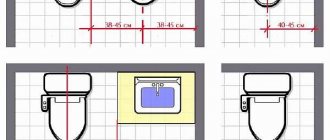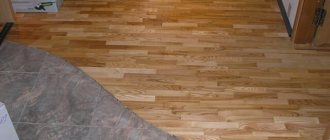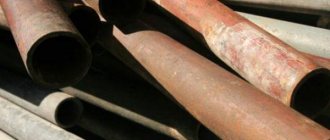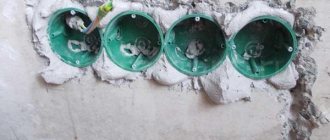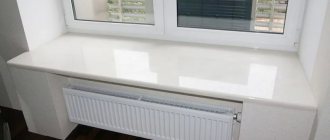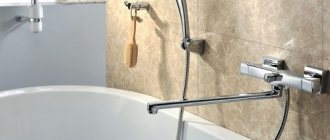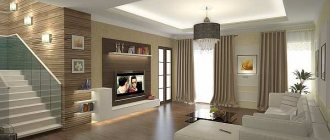Bathroom renovation includes several stages. However, it does not consist only of interior design. An important point in carrying out repair work is the installation of all elements in such a way that they are comfortable and convenient for each member of the household to use.
Such elements, first of all, include the mixer in the shower stall, and the main point is the height of its installation from the tray. This parameter depends on various nuances, but the main one is the individual preferences of users and the type of faucet itself. But are there certain rules for how to choose this distance and at what height the mixer should and can be installed? More on this later.
Standards for installing a mixer in a shower
Standards for the installation of plumbing in Russia are given in SNiP 3.05.01–85 “Internal sanitary systems”. It is recommended to install bathtub faucets at a height of 120 cm from the level of the finished floor, that is, from the surface formed after laying the finishing coating. For the bathroom this means from the surface of the floor tiles.
The document recommends moving on to installing sanitary fixtures after installing pipes and sewers, but you will have to calculate the mounting height of the fixture a little earlier. Otherwise, it is not clear at what height to install the pipes. If you are not sure that the measurements were made accurately, it is better to remove the pipes with a reserve, because cutting them is much easier than extending them.
For shower mixers, the installation height recommended by SNiP is 120 cm to the bottom of the shower tray or bathtub. But it is important to remember: these rules were created not for apartments, but for showers in institutions and sports complexes. In addition, at the very beginning of the document there is an important clause - the installation of plumbing must be carried out in accordance with the requirements of not only SNiPs, but also the instructions of the manufacturers. Therefore, the main document containing the installation standards for a specific mixer is the installation and operating instructions attached to it.
What should the height of the mixer be? In practice, installation of mixers is carried out taking into account the customer’s opinion and common sense.
A mixer in a shower differs from a regular one in that it is necessary to take into account two parameters: the distance from the taps to the bottom of the bathtub and the distance between the point where the shower hose is discharged and the attachment of the shower head.
In the first case, it is difficult to talk about standards: people have different heights, some take a bath while sitting or lying down, others prefer to shower while standing. There are families with children, and there are apartments where one or two tall adults live. The comfortable height of the location of the taps that regulate the water temperature depends not only on the anthropometric data of the apartment owners, but also on the type of mixer: you cannot install a single-lever and valve or thermostatic at the same height, for the user the difference will be 15-20 cm.
Customers usually ask to install the mixer 15-30 cm above the top edge of the bathtub. This interval is convenient for most people. As for attaching the watering can, it should be at such a level that it is comfortable for each family member to stand under the shower, everyone can take the watering can, and at the same time the hose hangs freely, but does not hang into the bathtub. This way it will last much longer.
If there are children in the family, the most convenient option for attaching a watering can will be a rod. With its help, each family member will be able to attach a watering can holder according to their height for a shower.
Regulatory Requirements
Regulatory requirements for the installation of pipeline fittings in accordance with SNiP 2.04.01 clause 10.5 are given in table No. 2.
Table 2. Regulatory requirements for the installation of pipeline fittings for cold and hot water supply
|
|
|
|
|
|
|
|
|
|
|
|
|
| ||
|
| ||
|
| ||
|
| ||
|
| ||
|
| ||
|
| ||
|
| ||
|
|
| |
|
|
| |
|
|
| |
|
|
| |
|
|
| |
|
|
|
|
|
|
| |
|
|
| |
|
|
|
|
|
|
|
|
|
|
|
|
|
| ||
|
| ||
|
| ||
|
| ||
|
|
|
|
|
| ||
|
| ||
|
|
When purchasing plumbing fixtures, the presence of invisible cracks is determined by ear by tapping the product, located on a wooden stand, with a wooden hammer weighing about 250 g. A product that has cracks makes a rattling sound when tapped.
The presence of nicks and scratches is determined visually by wiping the surface of the product with a cloth soaked in a 0.1% solution of methylene blue solution. If there are nicks or scratches, they are filled with a blue solution and are detected visually without the use of magnifying devices.
What determines the installation height of the mixer?
Often, in an attempt to save money, people plan to install a single bathtub faucet and an adjacent sink. It seems that they are not used at the same time; shower mixers are often equipped with long spouts that fully reach the sink, which means that one device is enough. This is a serious mistake. Firstly, constant turning will wear out the spout faster and will require at least annual repairs or even replacement. Secondly, the installation height of the mixer in this case is calculated based on the highest object. That is, according to the washbasin, which is usually installed no lower than 85 cm from the floor along the upper edge, and as a strict norm, SNIP recommends this only when installing a single mixer on a bathtub and sink. But it still turns out that the sink is located significantly higher than the top edge of the bathtub. As a result:
- the shower mixer is too high;
- the sink has to be installed at a height convenient for people 160-165 cm tall; everyone taller will have to bend over it, overloading the lower back muscles;
- you are limited in choosing the depth of the sink and the shape of the spout;
- installation under the sink of a washing machine becomes impossible.
The dubious benefit of purchasing one faucet instead of two is offset by significant inconvenience and increased costs for plumbing repairs.
Types and types of water sockets
Water inlet (VR) is a type of fitting for water pipes, which on one side has a standard connector for connecting to a pipe (depending on the type of pipe), on the other, a threaded connection to which a mixer eccentric or water supply hose is connected. VRs are distinguished by material, connector shape and configuration.
For the manufacture of VR use:
- stainless steel;
- galvanized cast iron;
- brass and bronze;
- PVC and polypropylene.
Stainless steel fittings are quite expensive, the average price of one fitting is 800 rubles. Working pressure – 10-20 atmospheres.
To connect stainless steel VR to copper pipes, use brass adapters. Connection to plastic and metal-plastic (metal-polymer) pipes is made without adapters, using a crimp coupling or tightening nut (depending on the type of connector). Connection to a corrugated stainless pipe is only possible for BP with a connector designed for such installation or through an adapter. Therefore, before purchasing, check the connector type.
VRs made of galvanized cast iron are cheaper than those made of stainless steel, the average price is 200 rubles. Technical parameters and connection are similar to stainless steel VR. If the protective layer is damaged, it rusts.
VR made of brass and bronze are even cheaper, the average price is 100 rubles. This type of VR is used more often than others. In terms of technical characteristics, it is not inferior to BP made of stainless steel. To connect to copper and steel pipes, you do not need an adapter (if the connector matches). The main types of connectors are compression and crimp.
VR made of PVC and polypropylene are the cheapest, the average price is 40 rubles. PVC fittings are used to connect plumbing fixtures to cold water supply (CWS), because the maximum temperature recommended for these CS is 40 degrees. Fittings made of polypropylene are used for cold and hot water supply (DHW). The working pressure is similar to stainless steel BP. Installation is carried out by soldering.
Do not use PVC BP for installation on polypropylene pipes and vice versa. These materials are not compatible for soldering.
Plastic water sockets
VR configuration
Single VR with 2 mounting holes. Used to connect transition hoses. Therefore, depending on the model, they are cut with external or internal threads of various diameters. When faucets are tightly connected, there is a high probability of damage to the fasteners. It is possible to install several VRs on a mounting plate to reduce the number of holes in the wall.
Single VR with 3 holes for fastenings. Used to connect transition hoses and mixers. Depending on the model, the fittings have external or internal threads of various diameters. Additional fastening at the top increases the rigidity and strength of the connection. Installation on a mounting strip is possible; to install the mixer, the strip is secured with 4 or more anchor dowels.
Double BPs on a short bar are used to connect adapter hoses. This reduces installation time. Application for connecting mixers is impossible due to the large difference in the distances between the installation locations and the BP thread.
Double VRs on a long bar are used to connect adapter hoses and install faucets (for this, use a bar with two rows of mounting holes, top and bottom). The use of such BPs facilitates the installation and connection of plumbing fixtures, because the distance between BPs corresponds to standard faucets.
Brass water sockets on mounting plate
Recommendations for choosing the height for installing the mixer
Planning the installation height of a shower is a task that is feasible for people without engineering or even plumbing education. This device forgives minor errors during installation. But there are several rules that must be followed:
- Having planned exactly how the mixer and watering can will be fixed, before starting installation, attach the already purchased device to the wall, stand in the bathtub or shower and evaluate how convenient this arrangement of the watering can and spout is for you;
- you need to count the distance to the attachment points of the mixer and watering can from the bottom of the bathtub or cabin, the distance from the floor is an unreliable value, it depends on the height of the legs of the bathtub and the thickness of its bottom, and as a result the shower may be fixed too low, which will negatively affect your comfort;
- however, it is necessary to measure the distance to the attachment points from the floor, lower surface and bottom of the bathtub; this data will help in other work;
- do not attach the device to the joint of the tiles and especially to the tiled border, otherwise the device will not be fixed well and will not last long, and high-quality reinstallation with such initial data will not be easy;
Measure twice, cut once - this proverb accurately conveys all the nuances of installing a shower faucet. Act slowly, think through everything down to the smallest detail, follow the technology - and then the device will last a long time, the device will look neat, and replacing it when the time comes will not cause difficulties.
Bath
Operating principle and types of watering cans “tropical rain”
A distinctive feature of the “Tropical Rain” shower is that the water is supplied through a special system that distributes the flow over the entire area of the grate, the dimensions of which can be quite significant.
The shape and design of watering cans can be very different. There are models with a water pressure control system, which, depending on the settings, can have both a relaxing and invigorating effect. The shape of watering cans can be very different
Watering cans with LED lighting are popular, the color of which changes depending on the temperature of the flow. Such systems enhance the therapeutic effect, since any shade of color has its own effect on the human psyche. A simple settings management system allows you to get the desired result.
Illuminated watering can
Watering cans with LED lighting
Shower with light
The range of watering cans is constantly updated. One of the new products is a shower complex equipped with a system for supplying fragrances with the scent of tropical plants.
The pleasure of water and a pleasant aroma
Some models have the option of randomly selecting pressure. Therefore, being in the shower gives you a feeling of unpredictability, characteristic of real rains.
The pressure and direction of the jets can be changed
Shape, material and dimensions of watering cans
Shower heads “Tropical Rain” can be round, oval, square, rectangular. For small shower rooms, both large and miniature ones are suitable. The choice depends on what effect they want to get from water procedures. When using large watering cans, the feeling of a tropical downpour is more realistic.
Rectangular watering can
Round watering can
Watering cans “Tropical Rain” can be steel, chrome-plated, brass, or nickel-plated. When choosing a model, you need to understand that the main thing in a shower system is the mixer and accessories for supplying water. The “Tropical Rain” watering can can be installed on any system.
Shower stand
Shower system with rain shower
Premium segment models have the maximum number of options. These include aeration technology (air supply), remote control, multi-colored lighting, protection against mineral deposits, and a system of adjustable and multidirectional water flow. Such shower complexes are the most expensive.
Waterfall shower with LED lighting
Shower head Lumière – Quadro
The aeration system allows you to break streams of water into droplets, which is especially appreciated in the “Tropical Rain” watering cans. The principle of its (system) operation is based on the use of a hydraulic turbine on point bearings. There is a hole in its center through which air is taken in. As the turbine blades rotate, they mix water and air, resulting in the formation of droplets. Adjusting the rotation mode allows you to obtain large and small droplets.
Shower Head
“Tropical Rain” shower heads can be installed in both built-in and wall-mounted shower systems. The installation method can be wall or ceiling. Models of the second type are called “overhead shower”.
Wall mount
Example of an overhead shower
Shower of impressions
shower head tropical rain
How to choose
When choosing rods for curtains in the bathroom, remember that it should not only be attractive in appearance, but also practical and lightweight. For example, if you do not like extraneous noise, then plastic will be ideal, since the movement of the rings along the metal rod will create additional sounds. To prevent this from happening, it is best to choose metal rings with an additional plastic coating to attach the curtains to the rod.
The minimum service life will be ensured by telescopic rods with vacuum pressure to the surface. This design can break from the slightest careless movement or sudden opening of the curtains. Not all rods are able to withstand heavy curtain models without deformation; this is important to remember when choosing. With a large length of the rod, you cannot do without ceiling or wall fastenings, which, if desired, can be turned into room decor. When purchasing a curtain rod, you need to pay attention to some nuances:
- connecting parts should occur without difficulty;
- Each structural element must be intact, without chips or defects. The coating of the rod must also be of high quality;
- all fastenings must be made of moisture-resistant materials.
Sources:
- https://vanna-expert.ru/santekhnika/shtanga-dlya-dusha-v-vannu.html
- https://stroy-podskazka.ru/vannaya/dush/shtanga/
- https://VannayaSovety.ru
- https://FB.ru/article/241730/shtanga-dlya-dusha-v-vannuyu-foto-ustanovka
- https://vashavannaya.ru/dushevye-stojki.htm
- https://GazPribor-Tambov.ru/santehnika/kak-prikrepit-derzhatel-dlya-dusha.html
- https://gidroguru.com
- https://KrepezhInfo.ru/kreplenie-dlya-dusha/
- https://VannayaSovety.ru
- 1
Popular models
Popular models include rods or holders that provide freedom of movement due to hinged devices. In addition to classic-type models, automatic and semi-automatic designs made of strong alloys are becoming increasingly popular.
The reliability of the manufacturer and the established reputation in the sales of plumbing fixtures are important aspects of choice. Among them are well-known brands that are in demand: Hansgrohe and Grohe.
These companies have existed for many years, they have a reliable reputation that guarantees the quality of their products. Installation of rods and other plumbing elements is done quickly, the details are consistent with the standards. Companies are developing the latest technologies, expanding their product catalog and improving quality.
Why does it break?
The most common cause is poor water quality. This includes an abundance of salts and the presence of unknown impurities. And, of course, rust. That is why a coarse filter must be installed at the entrance to the apartment; it is advisable to equip the entrance with a flow-through fine filter (but it is expensive and large in size).
Protect your pallet before you begin repairs. Or stand there with your bare feet. Handle the pallet coating with care because the restoration process is difficult.
Scanservice spare parts for plumbing equipment
- Plumbing and spare parts Gustavsberg Faucets and shower stands Gustavsberg
- Spare parts for Gustavsberg faucets
- Spare parts for toilets Gustavsberg
- Toilet seats and covers Gustavsberg
- Toilets and installations Gustavsberg
- Spare parts for shower cabins Ido Showerama
- Spare parts for Ifo shower cabins
- Spare parts for Roca faucets
- Spare parts for Jacob Delafon faucets
- Parts for Vitra faucets and basins
- Spare parts for toilets, installations, bathtubs, sinks Villeroy Boch
Why faucets fail: main reasons
The most common causes of device failure:
- The appliance has been used incorrectly or installed without following the instructions.
- Poor quality water contributes to the deposition of salts in the cartridge, which leads to its failure.
- Errors were made when assembling the mixer in production.
- Wear of moving parts of the structure.
- Rust forms in the movement channels and on the moving parts of the mixer.
To more accurately determine the cause, you need to remove the mixer.
Crane selection criteria
Repairing a shower valve is a simple process and involves simply replacing the faucet cartridge. As a rule, most owners are looking for a faucet to replace the hydrobox with the exact same model that was equipped with the shower stall. But this is not at all necessary - it is enough that the dimensions match, that is, the distance between the valve stems.
They have standard values - 100, 125, 145 and 150 mm. The distance is measured from the mode control lever to the water supply fitting. The device can have from 1 to 5 modes.
